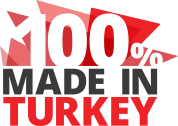Some basic information about the Mooney Viscometer and rubber viscosity measurement.
A Mooney viscometer is a test device specifically used to measure rheological properties such as viscosity, melting behavior, and stress relaxation of raw and compounded rubber materials. This test is critical in determining the performance and compatibility of the material during rubber processing.
What Does a Mooney Viscometer Measure?
The main parameter measured by a Mooney viscometer is the "Mooney viscosity." This value reflects the torsional resistance of the rubber specimen at a specified temperature and rotation speed. The stress relaxation test analyzes how the viscosity of the sample decreases after rotation is stopped.
These measurements provide structural insights such as molecular network structure, chain length, and molecular weight distribution.
Device Features
Modern Mooney viscometers are equipped with the following technological features:
PC-based software: Automation of the test process and detailed data analysis
Automatic calibration: Maintains accuracy before each test
Precise temperature control: Ensures constant temperature for test accuracy
Areas of Application
Mooney viscometers are widely used in the following applications:
Testing of raw and compounded rubber formulations
Routine inspection in quality control laboratories
Determining material acceptance criteria
Optimization of process parameters
Applicable Standards and Explanations
Mooney viscosity and stress relaxation tests should be performed according to the following national and international standards:
ASTM D1646-2017 (USA Standard): Defines test methods for Mooney viscosity and stress relaxation.
GB/T 1233-2008 and GB/T 1233.1-2016 (Chinese Standard): Test procedures compatible with Chinese-origin systems.
ISO 289-1:2015 and ISO 289-2:2016 (International Standard): Define Mooney viscosity (Part 1) and stress relaxation (Part 2) testing rules.
TS ISO 289-1 (Turkish Standard): Turkish Standards Institute's adopted version of ISO 289-1, applicable in Turkey.
These standards ensure comparability and repeatability of tests conducted in different laboratories.
Benefits of Mooney Viscosity Testing
Formulation compatibility: Verifies whether raw materials or additives conform to the desired formulation.
Material performance prediction: Predicts processing characteristics that will affect the final product.
Process optimization: Allows for parameter adjustments in units like mixing and extrusion.
Frequently Asked Questions (FAQs)
Which types of rubber are suitable for Mooney viscometers?
Natural rubber, synthetic rubber, and compounded rubber formulations can be tested.
At what temperature is Mooney viscosity measured?
Typically measured at fixed temperatures such as 100 °C, 121 °C, or 125 °C.
How long does the measurement process take?
Including preparation, it may take approximately 15-30 minutes.
Which standard is most commonly used?
ASTM D1646 and ISO 289-1 are the most widely accepted standards.
Are tests performed with Mooney viscometers sufficient for quality certifications?
Yes, when conducted according to international standards, they can be referenced in quality certifications.
RELATED PRODUCTS
RELATED SUBJECTS
- Battery Foil Peel and Tensile Tests: Electrode Layer Strength Analysis
- Melt Flow Index (MFI)
- Plastic Film Puncture Test
- Wet and Dry Tensile Tests for Paper and Board Materials
- What Is A Compression Test?
- What Is A Glow Wire Test?
- What Is Halogen-Free and Why Is It Important?
- What Is a Gloss Meter?
- What Is the Martindale Test and Why Is It Important?
- What is the Cobb Water Absorption Test Device and How to Use It?

